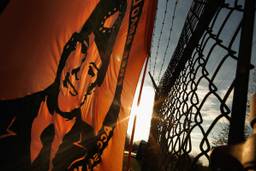
What do William Shakespeare’s the Tempest, Paulo Freire’s Pedagogy of the Oppressed and the textbook Critical Race Theory have in common? They all deal centrally with themes of colonization, race and oppression--and, therefore, they may no longer be taught in Tucson, Arizona schools.
Though it has been widely reported that these and other books have been banned, the Tucson Unified School District (TUSD) today insisted that these claims are misleading. Following the suspension of the school district’s Mexican American studies program in accordance with Arizona state law, the TUSD said in a statement that it has merely had the books “boxed and stored as part of the process of suspending the classes.” The books continue to be available through various school libraries, however.
The school district also refuted claims that the Tempest could not be taught in classrooms, asserting that “teachers may continue to use materials in their classrooms as appropriate for the course curriculum.”
This is where the story becomes more nuanced. In an interview with the Huffington Post, Tucson High School teacher Curtis Acosta explained that “The Tempest is problematic for [TUSD] administrators due to the content of the play and the pedagogical choices I have made.”
What pedagogical choice were those? The Arizona state law prohibits courses that “promote the overthrow of the United State government, promote resentment toward a race or class of people, are designed primarily for pupils of a particular ethnic group or advocate ethnic solidarity instead of the treatment of pupils as individuals.” In seeking to comply with this law, Acosta says administrators advised him “to avoid texts, units, or lessons with race and oppression as a central focus.”
So while there may not be a ban on the play itself, there are restrictions on what themes and interpretations instructors can highlight in important works.
Most troublingly, Costa notes:
We also have not received confirmation that the ideas, dialogue, and class work of our students will be protected. In clearer words, if I avoid discussing such themes in class, yet the students see the themes and decide to write, discuss or ask questions in class, we may also be found to be in violation. The stakes are far too high since a violation of the law could cost the district millions, our employment, and personal penalties from the state for breaking the law.
This all is, effectively, quite similar to a ban. Limiting the acceptable interpretations of a work insulates students from alternative perspectives and conflicting understandings--in other words, the stuff that teaches critical thinking.
Rebecca Burns also contributed copy for this post.
Please consider supporting our work.

I hope you found this article important. Before you leave, I want to ask you to consider supporting our work with a donation. In These Times needs readers like you to help sustain our mission. We don’t depend on—or want—corporate advertising or deep-pocketed billionaires to fund our journalism. We’re supported by you, the reader, so we can focus on covering the issues that matter most to the progressive movement without fear or compromise.
Our work isn’t hidden behind a paywall because of people like you who support our journalism. We want to keep it that way. If you value the work we do and the movements we cover, please consider donating to In These Times.
Alyssa Meza is a Winter 2012 In These Times editorial intern


